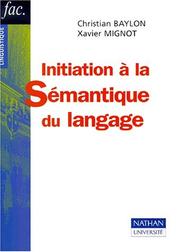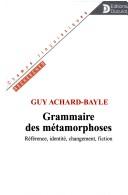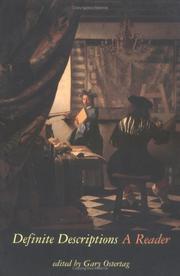
ISBN: 2091911038 9782091911038 Year: 2000 Publisher: Paris Nathan
Abstract | Keywords | Export | Availability | Bookmark
 Loading...
Loading...Choose an application
- Reference Manager
- EndNote
- RefWorks (Direct export to RefWorks)
801.56 --- 801.56 Syntaxis. Semantiek --- Syntaxis. Semantiek --- References (Linguistics). --- Référence (Linguistique). --- Signification (linguistique). --- Pragmatique (linguistique). --- Language. --- Semantics. --- Semantiek. --- Semantik. --- Sémantique.
Book
ISBN: 284788176X 2847884343 9782847881769 Year: 2009 Publisher: Lyon: École normale supérieure,
Abstract | Keywords | Export | Availability | Bookmark
 Loading...
Loading...Choose an application
- Reference Manager
- EndNote
- RefWorks (Direct export to RefWorks)
Through the study of numerous Sanskrit technical texts, the present study aims to show and explain how the specificity of the semiotic status of proper names has been approached in the three traditional Indian disciplines of vy ā kara ṇ a (grammar), the ny at are (logical) and m ī m at m s at (exegesis), disciplines that put the reflection on language at the centre of their concerns. The question of the "meaning" of proper names has given rise to many reflections, both in the West and in India.If the debates, in the West, mainly concern logic and philosophy, linguistics participating only marginally, it is primarily grammarians ( vaiy à kara ṇ a ) and logicians ( naiy à yika ) who, in India, got hold of the problem. This work shows how the former mostly defended the idea that proper nouns denote and connote, while among the latter, it is the idea of a direct denotation, without connotation, which was most often supported.
Names, Personal --- Names, Sanskrit --- Related Historical Sciences --- History & Archaeology --- Genealogy --- Sanskrit language --- Sanskrit names --- Names --- Names, Personal - India --- nom propre --- convention linguistique --- langues indiennes --- référence (linguistique) --- sanskrit
Book
ISBN: 9782847887983 2847887989 2847888004 2847887997 9782847887990 9782847888003 Year: 2016 Publisher: Lyon ENS Editions
Abstract | Keywords | Export | Availability | Bookmark
 Loading...
Loading...Choose an application
- Reference Manager
- EndNote
- RefWorks (Direct export to RefWorks)
"Cet ouvrage regroupe un ensemble de contributions scientifiques destinées à éclairer divers aspects des recherches menées en France durant ces quarante dernières années autour de la cohésion et de la cohérence des textes. Les auteurs réunis dans ce volume ont ainsi souhaité rendre hommage à leur collègue et ami le professeur Michel Charolles, dont les nombreux travaux constituent un apport majeur au développement de la linguistique textuelle en France. Un accent particulier y est mis sur sa vision renouvelée des marqueurs de cohésion discursive, à la suite de ses travaux sur "l'encadrement du discours" (1997). Ces marqueurs qui guident l'interprétant dans l'accès à la cohérence du discours se regrouperaient en deux grandes familles : les marqueurs de connexion d'une part, d'indexation d'autre part. Les premiers, qui réunissent les marqueurs de continuité référentielle (anaphores) et les marqueurs de relations entre les contenus propositionnels et/ou les actes de langage (connecteurs), permettent d'établir des liens de cohésion discursive avec le cotexte amont. Les seconds, projectifs, exercent leur portée vers le cotexte aval et permettent au locuteur d'indexer des segments textuels potentiellement étendus au sein d'unités sémantico-pragmatiques que Michel Charolles a proposé de nommer "cadres de discours".
Discourse analysis. --- Cohesion (Linguistics) --- Référence (linguistique) $2 rameau --- Cohérence (linguistique) $2 rameau --- Marqueurs discursifs $2 rameau --- Cohesion (Linguistics). --- French language --- Pragmatics --- Référence (linguistique) --- Cohérence (linguistique) --- Marqueurs discursifs --- Marqueurs discursifs. --- Référence (linguistique) --- Cohérence (linguistique) --- Linguistics --- cohérence --- indexation --- cohésion --- texte --- coherence --- cohesion --- connection --- text --- Discourse analysis
Book
ISBN: 9780198790358 019879035X 0191837024 Year: 2016 Publisher: Oxford Oxford University Press
Abstract | Keywords | Export | Availability | Bookmark
 Loading...
Loading...Choose an application
- Reference Manager
- EndNote
- RefWorks (Direct export to RefWorks)
Philosophy of language --- Language and languages --- Philosophy of mind. --- Reference (Linguistics) --- Reference (Philosophy) --- Thought and thinking. --- Pensée --- Référence (Philosophie) --- Référence (Linguistique) --- Langage et langues --- Philosophie de l'esprit --- Philosophy. --- Philosophie --- Pensée --- Référence (Philosophie) --- Référence (Linguistique)

ISBN: 2801112844 9782801112847 Year: 2001 Volume: *19 Publisher: Bruxelles: De Boeck-Duculot,
Abstract | Keywords | Export | Availability | Bookmark
 Loading...
Loading...Choose an application
- Reference Manager
- EndNote
- RefWorks (Direct export to RefWorks)
Lexicology. Semantics --- Philosophy of language --- Grammar --- French language --- Reference (Linguistics) --- Fictions, Theory of --- Français (Langue) --- Référence (Linguistique) --- Théorie de la fiction --- Grammaire --- Grammar, Comparative and general --- 804.0-56 --- #KVHA:Grammatica; Frans --- Frans: syntaxis; semantiek --- Grammar, Comparative and general. --- 804.0-56 Frans: syntaxis; semantiek --- Français (Langue) --- Référence (Linguistique) --- Théorie de la fiction --- Comparative grammar --- Grammar, Philosophical --- Grammar, Universal --- Language and languages --- Philosophical grammar --- Linguistics --- Philology --- Grammar, Comparative --- Fictions, Theory of. --- Français (langue) --- Grammaire générative. --- Indexicalité. --- Reference (Linguistics). --- Référence (Linguistique). --- Référence (linguistique). --- Théorie de la fiction. --- identité --- identité. --- référence (langage) --- texte. --- Énonciation (linguistique). --- Grammaire. --- Référence. --- Sémantique. --- Grammar. --- Reference. --- Semantics. --- Référence (langage) --- Changement --- Texte. --- Changement. --- Point de vue (linguistique) --- Référence (linguistique) --- Fiction, Théorie de la --- Analyse du discours narratif --- Ontologie --- Référence
Book
ISBN: 9155450008 9789155450007 Year: 2001 Volume: 63 Publisher: Uppsala: Acta universitatis Upsaliensis,
Abstract | Keywords | Export | Availability | Bookmark
 Loading...
Loading...Choose an application
- Reference Manager
- EndNote
- RefWorks (Direct export to RefWorks)
Linguistics --- Frans (Taal) --- Franse taal --- Français (Langue) --- French language --- Reference (Linguistics) --- Référence (Linguistique) --- Verwijzing (Taalwetenschap) --- French philology --- Philologie française --- Festschrift - Libri Amicorum --- French philology. --- Philologie française --- Jonasson, Kerstin --- Grammar --- French literature --- History and criticism
Book
ISBN: 9782708015913 2708015915 Year: 2021 Publisher: Paris: Ophrys,
Abstract | Keywords | Export | Availability | Bookmark
 Loading...
Loading...Choose an application
- Reference Manager
- EndNote
- RefWorks (Direct export to RefWorks)
Qu'est-ce qui permet de comprendre qu'une suite d'expressions telle que Barack Obama... l'ex-président des USA... le mari de Michelle ... il désigne la même personne ? Par quels mécanismes linguistiques et cognitifs parvient-on à relier ces expressions ? Comment appréhender, suivre et mémoriser, le thème principal d'un discours écrit ou oral ? Comment introduire un référent dans un texte ? Avec quels outils grammaticaux et lexicaux peut-on en élaborer le " tracé " pour former un texte bien formé, cohésif et cohérent ? C'est à ces questions qu'entend répondre cet ouvrage à travers la notion de chaînes de référence, qui définit les séquences d'expressions renvoyant à une même entité.
French language --- Français (langue) --- Reference --- Référence (linguistique). --- Reference (Linguistics) --- Cohesion (Linguistics) --- Référence (linguistique) --- Langue d'oïl --- Romance languages --- 804.0-56 --- 804.0-56 Frans: syntaxis; semantiek --- Frans: syntaxis; semantiek

ISBN: 0262650495 Year: 1998 Publisher: Cambridge, Mass. MIT
Abstract | Keywords | Export | Availability | Bookmark
 Loading...
Loading...Choose an application
- Reference Manager
- EndNote
- RefWorks (Direct export to RefWorks)
Philosophy of language --- Definiteness (Linguistics) --- Description (Philosophy) --- Language and languages --- -Reference (Linguistics) --- Signification (Linguistics) --- Linguistics --- Onomasiology --- Semantics --- Foreign languages --- Languages --- Anthropology --- Communication --- Ethnology --- Information theory --- Meaning (Psychology) --- Philology --- Philosophy --- Indefiniteness (Linguistics) --- Grammar, Comparative and general --- Determiners --- Reference (Linguistics) --- Philosophy. --- Definiteness (Linguistics). --- Description (Philosophy). --- Reference (Linguistics). --- LANGAGE ET LANGUES --- DESCRIPTION (PHILOSOPHIE) --- DEFINIS --- REFERENCE (LINGUISTIQUE) --- PHILOSOPHIE --- Philosophie du langage
Book
ISBN: 9780199659999 9780199659982 0199659990 0199659982 0191635464 1299195830 0191745405 Year: 2012 Publisher: Oxford Oxford University Press
Abstract | Keywords | Export | Availability | Bookmark
 Loading...
Loading...Choose an application
- Reference Manager
- EndNote
- RefWorks (Direct export to RefWorks)
Francois Recanati presents his theory of mental files, a new way of understanding reference in language and thought. He aims to recast the 'nondescriptivist' approach to reference that has dominated the philosophy of language and mind in the late twentieth century. According to Recanati, we refer through mental files, which play the role of so-called 'modes of presentation'. The reference of linguistic expressions is inherited from that of the files we associate with them. The reference of a file is determined relationally, not satisfactionally: so a file is not to be equated to the body of (mis)information it contains. Files are like singular terms in the language of thought, with a nondescriptivist semantics.In contrast to other philosophers, Recanati offers an indexical model according to which files are typed by their function, which is to store information derived through certain types of relation to objects in the environment. The type of the file corresponds to the type of contextual relation it exploits. Even detached files or 'encyclopedia entries' are based on epistemically rewarding relations to their referent, on Recanati's account. Among the topics discussed in this wide-ranging book are: acquaintance relations and singular thought; cognitive significance; the vehicle/content distinction; the nature of indexical concepts; co-reference de jure and judgments of identity; cognitive dynamics; recognitional and perceptual concepts; confused thought and the transparency requirement on modes of presentation; descriptive names and 'acquaintanceless' singular thought; the communication of indexical thoughts; two-dimensional defences of Descriptivism; the Generality Constraint; attitude ascriptions and the 'vicarious' use of mental files; first-person thinking; token-reflexivity in language and thought.
Philosophy of language --- Thought and thinking. --- Reference (Philosophy). --- Reference (Linguistics). --- Language and languages --- Philosophy of mind. --- Pensée --- Référence (Philosophie) --- Référence (Linguistique) --- Langage et langues --- Philosophie de l'esprit --- Philosophy. --- Philosophie --- Pensée --- Référence (Philosophie) --- Référence (Linguistique) --- Memory.
Book
ISBN: 9780262034555 0262034557 0262335328 9780262335324 9780262335317 026233531X 0262335336 Year: 2016 Publisher: Cambridge, Massachusetts : The MIT Press,
Abstract | Keywords | Export | Availability | Bookmark
 Loading...
Loading...Choose an application
- Reference Manager
- EndNote
- RefWorks (Direct export to RefWorks)
"To communicate, speakers need to make it clear what they are talking about. The act of referring, which anchors words to things, is a fundamental aspect of language. In this book, Kees van Deemter shows that computational models of reference offer attractive tools for capturing the complexity of referring. Indeed, the models van Deemter presents cover many issues beyond the basic idea of referring to an object, including reference to sets, approximate descriptions, descriptions produced under uncertainty concerning the hearer's knowledge, and descriptions that aim to inform or influence the hearer. The book, which can be read as a case study in cognitive science, draws on perspectives from across the cognitive sciences, including philosophy, experimental psychology, formal logic, and computer science. Van Deemter advocates a combination of computational modeling and careful experimentation as the preferred method for expanding these insights. He then shows this method in action, covering a range of algorithms and a variety of methods for testing them. He shows that the method allows us to model logically complicated referring expressions, and demonstrates how we can gain an understanding of reference in situations where the speaker's knowledge is difficult to assess or where the referent resists exact definition. Finally, he proposes a program of research that addresses the open questions that remain in this area, arguing that this program can significantly enhance our understanding of human communication"--MIT CogNet.
Lexicology. Semantics --- Psycholinguistics --- Mathematical logic --- Mathematical linguistics --- Reference (Linguistics) --- Presupposition (Logic) --- Computational linguistics. --- Référence (linguistique) --- Présupposition (logique) --- Linguistique --- Informatique --- Informatique. --- Signification (Linguistics) --- Linguistics --- Onomasiology --- Semantics --- Automatic language processing --- Language and languages --- Language data processing --- Natural language processing (Linguistics) --- Applied linguistics --- Cross-language information retrieval --- Multilingual computing --- Language and logic --- Logic --- Data processing --- LINGUISTICS & LANGUAGE/General --- COGNITIVE SCIENCES/General --- COMPUTER SCIENCE/General

 Search
Search Feedback
Feedback About UniCat
About UniCat  Help
Help News
News